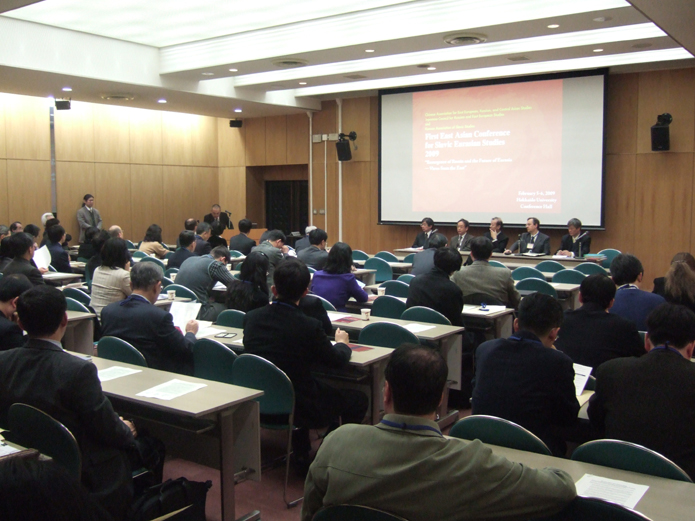|
The First East Asian Conference for Slavic
Eurasian Studies,
February 5-6, 2009
February
11, 2009, by Kimitaka Matsuzato
On February
5-6, 2009, the three Slavicist associations of East Asia, the Chinese
Association for East European, Russian, and Central Asian Studies
(CAEERCAS), the Japanese Council for Russian and East European Studies
(JCREES), and the Korean Association for Slavic Studies (KASS) held the
First East Asian Conference for Slavic Eurasian Studies.
Nearly a year before, on February 22, 2008, representatives of these
associations had a summit meeting at Seoul University to develop
academic cooperation between the Slavicists of East Asia. We formulated
our agreement as a Memorandum of Understanding, which was signed by the
presidents of the three associations on May 7, 2008. Article 2 of the
memorandum proposes to convene an East Asian conference for Slavic
Eurasian studies annually. The JCREES was honored to be the first host
organization of this event.
We have already realized some of the core ideas of this memorandum: the
CAEERCAS was recognized as a full member of the ICCEES, the world
Slavicist organization, and the KASS normalized its relations with the
ICCEES. Asian Slavicists began to play a more deserving and adequate
role in the world Slavicist community.
After the ICCEES Council meeting in Stockholm on June 28, 2008, the
Korean and Japanese representatives had a talk to finalize the format
and date of the first East Asian conference. The president of the
CAEERCAS, Professor Li Jingjie, could not make it to Stockholm because
of passport reasons, but the JCREES and KASS immediately coordinated
the format with the CAEERCAS. We called for panel proposals and papers
from September to November, 2008. Eventually, we received more than 90
proposals. Since the ICCEES advertised this event, we received a number
of proposals from outside Asia: seven from Russia, one from Belarus,
one from the United States, and two from Malaysia. Regrettably, we did
not have a budget to aid these scholars to come to Sapporo, but
eventually, six papers were presented by the participants from outside
East Asia.
The world financial crisis damaged the participation from East Asia,
but nevertheless, we have managed to organize 24 panels with 75 papers:
24 papers from Korea, 19 papers from Japan (among them 6 from foreign
scholars staying in Japan), 16 papers from China, one from Taiwan,
three from Russia, and one representative each from Mongolia, Malaysia
and the US.
Hokkaido University generously aided the conference, and the
Grant-in-aid for Scientific Research on Innovative Areas, “Comparative
Research on Major Regional Powers in Eurasia,” played an important role
in organizing panels.
Remarkably, 69 of the 75 papers (92%) were preliminary submitted and
uploaded on the HP. When the AAASS and ICCEES are losing the decent
tradition of preliminary paper distribution, the Asian correctness
looks even more impressive. The discussions at the panels were very
lively and demonstrated the high level of Slavicist studies in Asia. To
promote publications of the papers, we invited a representative of a
D.C. Journal, Demokratizatsiya, Professor Christopher Marsh of Baylor
University, as an observer of this conference. He appreciated the
contents of the conference and is working on the publication of a
number of papers.
Last but not least, the experience and mutual acquaintance of Asian
Slavicists during the preparation of the first East Asian conference
helped overcome serious challenges to organizing panels at
international academic conventions. In fact, an unprecedented number of
Korean and Chinese colleagues have proposed panels and papers to the
ICCEES world congress, which will be held in Stockholm on July 26-31,
2010

*The views expressed in the essay belong
solely to the author and do not represent the official position of any
organizations to which the author is permanently or was temporarily
affiliated.
[index]
|

